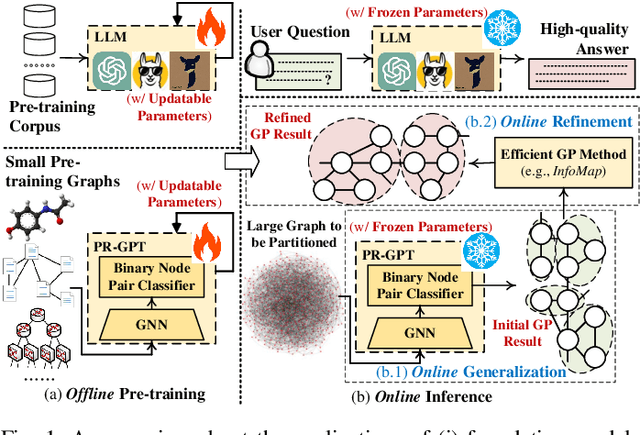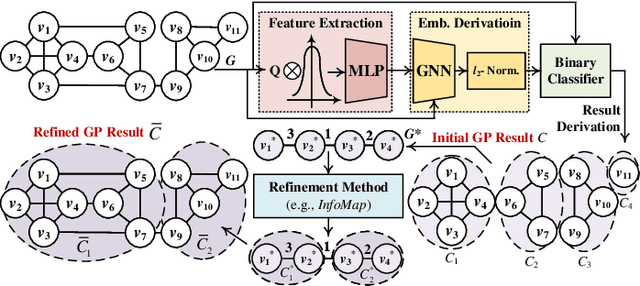Chaorui Zhang
Towards Faster Graph Partitioning via Pre-training and Inductive Inference
Sep 01, 2024



Abstract:Graph partitioning (GP) is a classic problem that divides the node set of a graph into densely-connected blocks. Following the IEEE HPEC Graph Challenge and recent advances in pre-training techniques (e.g., large-language models), we propose PR-GPT (Pre-trained & Refined Graph ParTitioning) based on a novel pre-training & refinement paradigm. We first conduct the offline pre-training of a deep graph learning (DGL) model on small synthetic graphs with various topology properties. By using the inductive inference of DGL, one can directly generalize the pre-trained model (with frozen model parameters) to large graphs and derive feasible GP results. We also use the derived partition as a good initialization of an efficient GP method (e.g., InfoMap) to further refine the quality of partitioning. In this setting, the online generalization and refinement of PR-GPT can not only benefit from the transfer ability regarding quality but also ensure high inference efficiency without re-training. Based on a mechanism of reducing the scale of a graph to be processed by the refinement method, PR-GPT also has the potential to support streaming GP. Experiments on the Graph Challenge benchmark demonstrate that PR-GPT can ensure faster GP on large-scale graphs without significant quality degradation, compared with running a refinement method from scratch. We will make our code public at https://github.com/KuroginQin/PRGPT.
Trading off Quality for Efficiency of Community Detection: An Inductive Method across Graphs
Sep 29, 2022



Abstract:Many network applications can be formulated as NP-hard combinatorial optimization problems of community detection (CD). Due to the NP-hardness, to balance the CD quality and efficiency remains a challenge. Most existing CD methods are transductive, which are independently optimized only for the CD on a single graph. Some of these methods use advanced machine learning techniques to obtain high-quality CD results but usually have high complexity. Other approaches use fast heuristic approximation to ensure low runtime but may suffer from quality degradation. In contrast to these transductive methods, we propose an alternative inductive community detection (ICD) method across graphs of a system or scenario to alleviate the NP-hard challenge. ICD first conducts the offline training of an adversarial dual GNN on historical graphs to capture key properties of the system. The trained model is then directly generalized to new unseen graphs for online CD without additional optimization, where a better trade-off between quality and efficiency can be achieved. ICD can also capture the permutation invariant community labels in the offline training and tackle the online CD on new graphs with non-fixed number of nodes and communities. Experiments on a set of benchmarks demonstrate that ICD can achieve a significant trade-off between quality and efficiency over various baselines.
Enhanced high dynamic range 3D shape measurement based on generalized phase-shifting algorithm
Jun 07, 2016
Abstract:It is a challenge for Phase Measurement Profilometry (PMP) to measure objects with a large range of reflectivity variation across the surface. Saturated or dark pixels in the deformed fringe patterns captured by the camera will lead to phase fluctuations and errors. Jiang et al. proposed a high dynamic range real-time 3D shape measurement method without changing camera exposures. Three inverted phase-shifted fringe patterns are used to complement three regular phase-shifted fringe patterns for phase retrieval when any of the regular fringe patterns are saturated. But Jiang's method still has some drawbacks: (1) The phases in saturated pixels are respectively estimated by different formulas for different cases. It is shortage of an universal formula; (2) it cannot be extended to four-step phase-shifting algorithm because inverted fringe patterns are the repetition of regular fringe patterns; (3) only three unsaturated intensity values at every pixel of fringe patterns are chosen for phase demodulation, lying idle the other unsaturated ones. We proposed a method for enhanced high dynamic range 3D shape measurement based on generalized phase-shifting algorithm, which combines the complementary technique of inverted and regular fringe patterns with generalized phase-shifting algorithm. Firstly, two sets of complementary phase-shifted fringe patterns, namely regular and inverted fringe patterns are projected and collected. Then all unsaturated intensity values at the same camera pixel from two sets of fringe patterns are selected, and employed to retrieve the phase by generalized phase-shifting algorithm. Finally, simulations and experiments are conducted to prove the validity of the proposed method. The results are analyzed and compared with Jiang's method, which demonstrate that the proposed method not only expands the scope of Jiang's method, but also improves the measurement accuracy.
 Add to Chrome
Add to Chrome Add to Firefox
Add to Firefox Add to Edge
Add to Edge